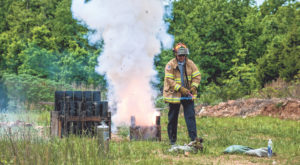
Story and photo by Dawn Arden
Public Affairs Office
FORT LEONARD WOOD, Mo. (May 24, 2018) — Summer is here, and plans for the installation’s annual Independence Day Celebration are in the works. Fort Leonard Wood holds one of the area’s largest fireworks displays, making safety and fire prevention a big part of the planning process.
In order to ensure those attending enjoy the show safely, the Fort Leonard Wood Fire Department hosted a National Fire Protection Association certification class May 15 with several Department of Defense Fire Departments from neighboring states in attendance, in addition to hospital and safety personnel.
The class, taught by NFPA 1123 committee member Matt Sutcliffe, gives passing students a three-year certification, while teaching them what a proper fireworks setup should look like.
“Planning, setting up and firing fireworks affect public safety, and thus a degree of certification is essential before an individual can be certified as a fireworks inspector,” said Kevin Curtis, Fire Prevention assistant chief. “This NFPA certification class will keep us up to date for three years while keeping the Fort Leonard Wood community safe from fire.”
With fireworks season quickly approaching, Curtis said he reached out to Fire Prevention Assistant Chiefs, located at nearby installations, giving them the opportunity to attend, as well. A fire prevention team from Whiteman Air Force Base was among the departments that took the opportunity.
“Whiteman does an annual fireworks display for the base populace, and this course will help us ensure these events are as safe as possible,” said Tim Robinson, Whiteman Air Force Base Fire Department, Fire Prevention assistant chief.
The course was split into two parts: a classroom session followed by hands-on demonstrations.
“At the end of this certification class, each student will be able to inspect a public fireworks display in order to verify (proper) storage, handling and use complies with applicable codes and standards,” Curtis said.
He said students will also be able to identify, document and report deficiencies in accordance with codes, standards and jurisdictional policies.
According to the National Fire Protection Association, 18,500 fires per year are a result of fireworks. This further breaks down into 1,300 structure fires, 300 vehicle fires and 16,900 other fires.
The Consumer Product Safety Commission’s 2015 Fireworks Annual Report states, of the 11,900 firework-related emergency-room visits reported that year, 51 percent were to the extremities, and 41 percent were head injuries. Children ages 15 and younger accounted for 26 percent of all injuries.
